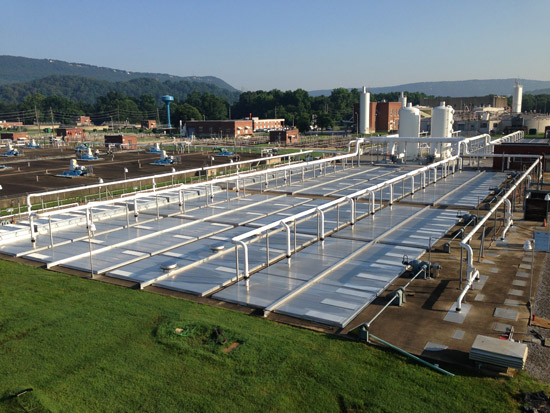Aluminum Covers
Aluminum Covers Municipal Wastes
Domes, vaults, extruded flat covers, formed flat panels, truss supported covers, space frames and any other configuration required to contain odors from waste water can be designed with aluminum.
 |
Installing an aluminum flat plate cover over their wastewater allowed Chattanooga to continue their commitments to sustainability. Photo © Haren Construction Co., Inc. |
One of the first communities to sign the U.S. Conference of Mayors Climate Protection Agreement, Chattanooga, Tennessee began to commit itself to the creation of a sustainable community. When the American Institute of Architects Sustainable Design Discussion Group was given a tour of this commitment in 2007, one of the most eager participants were those in the waste management division of the city. Their goal was to achieve Class A sludge treatment turning waste into biosolids that can be used as fertilizer. Developing state of the art treatment plants with aluminum covers provided them with an efficient system that was easy to maintain and monitor.
There are clear advantages to choosing this aluminum for wastewater containment covers. These include the ability to span long distances, noncorrosive properties, the excellent strength-to-weight ratio, constructability, recyclability and overall sustainability. The increase in population growth throughout the world means the decrease in the ability to hide the infrastructure and associated odors from wastewater systems. An attractive, durable and sustainable solution to the problem is an aluminum cover, custom designed to meet the harsh challenges of wastewater treatment.
The Sludge Handling Process in New Hampshire |
“The Sludge Handling Process comprises several steps in the wastewater treatment process. The first is to move the generated waste activated from the secondary clarifiers. Thickening occurs in three tanks that receive settled solids from the primary and secondary clarifiers and allow further solid/liquid separation. These are much smaller in diameter than the primary and secondary clarifiers and are housed in the treatment plant building. The solid content of settled sludge is estimated at ± 3 percent (three to five times more concentrated than primary sludge and up to 100 times more concentrated than waste activated sludge. Sludge Dewatering - The thickened sludge from the gravity thickeners is pumped to one of three centrifuges for dewatering. The ± 3% sludge that is drawn from the thickeners has polymer added to it before being introduced into the centrifuge. The centrifuge, through an interior screw moves the thin sludge through a spinning bowl. The bowl can spin up to 2,900 rpm. The water is spun out of the sludge as it is moved down the screw auger for final discharge. The final solid content of the discharged sludge is regulated to 23 percent ±. This sludge content is capable of being burned in the incinerator without the addition of oil as an auxiliary fuel. When the incinerator is down for maintenance, the sludge content can be spun to a solid content of >30 percent. Incineration - The fluidized bed incinerator is sized to burn all of the sludge and scum produced at the plant while meeting all New Hampshire and EPA air emission regulations. The plant has one fluidized bed incinerator that is operated during dewatering to burn the sludge produced by the belt filter press. During the two weeks of the year when the incinerator is down for preventative maintenance, sludge is trucked to an approved landfill. Odors - Sludge processing can be a nasty business and create substantial odors. Manchester has spent several million dollars over the past several years doing all possible to eliminate these offensive odors. Mist Chamber Odor Control System – A new 40,000 cubic foot per minute (cfm) mist chamber odor control system was constructed to treat odors from the air above the gravity thickeners, the sludge dewatering area, and the scum thickening area. Activated carbon odor control systems were added for treatment of air from the wet well and influent channel areas in the Influent Pump Station, also known as the headworks, and the Septage Receiving Facility. In each case, the odorous areas were contained by barriers such as aluminum plating or fiberglass covers, in order to reduce the volume of air to be treated. This minimized the capital as well as operating cost of the new odor control systems. Bio-Filter Covers – In 1998, covers were put over the primary clarifiers and channels leading to the clarifiers, as well as the grit channels and the aeration tanks. The odors from these tanks are treated by the use of an earth Bio-filter.”vi |
ENDNOTES |
|
| i | https://www.halton.ca/cms/One.aspx?portalId=8310&pageId=19514#Q1 |
| ii | United States Army Corps of Engineers. EM 1110-2-1614 Design of Seawalls and Bulkheads. Washington DC: USACE, 1995 |
| iii | http://aluminum.org/Content/ContentFolders/Miscellaneous/Aluminum_ The_Elemen.htm |
| iv | Ibid |
| v | Ibid |
| vi | http://www.manchesternh.gov/Departments/Environmental-Protection/Wastewater/Wastewater-Sludge-Handling |
 |
CST Industries has installed more than 350,000 tanks and 19,000 covers around the world. It is home to world-class brands, such as Aquastore, TecTank, (formerly Columbian TecTank and Peabody TecTank) and OptiDome. The products are manufactured in U.S. ISO 9001:2015 Certified facilities and supported by service teams worldwide. www.cstindustries.com |








